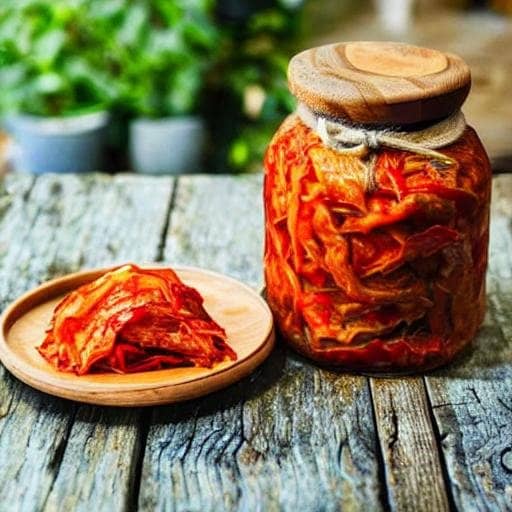Kimchi has become a popular dish worldwide, known for its vibrant flavors and health benefits. This traditional Korean dish is a spicy, fermented side dish made with vegetables and a variety of seasonings. In this article, we will explore the fascinating world of kimchi recipes, from its history and health benefits to various recipes you can try at home.
1. Introduction to Kimchi Recipes
What is Kimchi?
Kimchi is a staple in Korean cuisine, and it has a rich history that dates back thousands of years. It is a traditional fermented dish made primarily with cabbage, radishes, or cucumbers, combined with a mixture of salt, garlic, ginger, chili peppers, and other seasonings. The combination of flavors creates a unique and complex taste that is both spicy and tangy.
Historical Background
Kimchi has a deep-rooted history in Korean culture. It was originally developed as a way to preserve vegetables during the harsh winters. Over time, different regional variations of kimchi emerged, each with its own unique ingredients and preparation methods. Today, kimchi is not only a beloved dish in Korea but also enjoyed by people around the world.
2. Health Benefits of Kimchi Recipes
Kimchi is not just delicious; it also offers several health benefits. Let’s explore some of the reasons why you should consider adding kimchi to your diet.
Nutritional Value
Kimchi is packed with essential vitamins and minerals. It is a low-calorie food that provides a good amount of dietary fiber, vitamin C, vitamin K, and folate. Additionally, kimchi contains beneficial compounds like beta-carotene, calcium, and iron.
Probiotic Properties
One of the most significant health benefits of kimchi is its probiotic properties. During the fermentation process, lactic acid bacteria naturally form, aiding in digestion and promoting a healthy gut. These beneficial bacteria can improve digestion, strengthen the immune system, and even enhance mental health.
Antioxidant Content
Kimchi is also a rich source of antioxidants, which help protect the body against free radicals. The vibrant colors of the vegetables used in kimchi indicate the presence of antioxidants such as beta-carotene and vitamin C. Antioxidants are essential for maintaining overall health and reducing the risk of chronic diseases.
3. Traditional Kimchi Recipe
Making traditional kimchi requires a few key ingredients and a little bit of patience. Here’s a step-by-step guide to creating your own homemade kimchi.
Ingredients
- 1 medium Napa cabbage
- 1 daikon radish
- 4-5 green onions
- 4 cloves of garlic
- 1 small piece of ginger
- 2 tablespoons of Korean chili flakes (gochugaru)
- 2 tablespoons of fish sauce
- 1 tablespoon of salt
- 1 tablespoon of sugar
Preparation Steps
- Cut the Napa cabbage in half lengthwise and remove the core. Chop the cabbage into bite-sized pieces and place them in a large bowl.
- Sprinkle salt over the cabbage and toss well to distribute the salt evenly. Let it sit for about 2 hours, occasionally tossing the cabbage to ensure even salting.
- Rinse the cabbage under cold water to remove excess salt. Squeeze out the excess water and set aside.
- In a blender or food processor, blend the garlic, ginger, fish sauce, Korean chili flakes, and sugar to create a paste.
- Thinly slice the daikon radish and green onions.
- In a large bowl, combine the cabbage, radish, green onions, and the paste. Mix well, ensuring the vegetables are coated with the paste.
- Transfer the mixture to a clean, airtight jar or container. Press the kimchi down firmly to remove any air bubbles and seal the container.
- Let the kimchi ferment at room temperature for 1-2 days, depending on your preference. Once fermented, transfer it to the refrigerator for long-term storage.
⭐ At SmoothiePerks, we’ve written a blog post about Fermented Pickles – which you might be interested in reading.
4. Variations of Kimchi
Kimchi comes in various styles and flavors. Here are three popular variations you should try.
Baechu Kimchi (Napa Cabbage Kimchi)
Baechu kimchi is the most well-known type of kimchi. It features Napa cabbage as the main ingredient and is often the go-to choice for beginners. The cabbage leaves are coated with a flavorful paste, providing a perfect balance of spiciness and tanginess.
Kkakdugi (Radish Kimchi)
Kkakdugi is a kimchi made with cubed radishes. It has a crisp texture and a milder taste compared to baechu kimchi. Kkakdugi is a versatile side dish that complements many Korean meals.
Oi Sobagi (Stuffed Cucumber Kimchi)
Oi Sobagi is a refreshing kimchi made with cucumbers. The cucumbers are hollowed out and stuffed with a combination of radish, garlic, ginger, and other seasonings. Oi Sobagi offers a delightful crunch and is perfect for those who prefer a milder version of kimchi.
5. Vegan and Gluten-Free Kimchi Recipes
If you’re following a vegan or gluten-free diet, you can still enjoy the flavors of kimchi by making a few modifications. Here are some alternative ingredients and preparation methods.
Alternative Ingredients
To make vegan kimchi, replace fish sauce with soy sauce or tamari. You can also use miso paste for added umami flavor. Ensure that the chili flakes and other seasonings you use are free from any added gluten or animal-derived ingredients.
Modifications in Preparation
Follow the traditional kimchi recipe mentioned earlier but omit the fish sauce. Instead, add an extra tablespoon of salt and a tablespoon of soy sauce or tamari. Adjust the seasoning to taste, and you’ll have a delicious vegan and gluten-free kimchi ready to enjoy.
⭐ At SmoothiePerks, we’ve written a blog post about the Benefits of Fermented Food – which you might be interested in reading.
6. Kimchi in Fusion Cuisine
Kimchi’s unique flavors can be incorporated into various fusion dishes. Here are a few creative ways to use kimchi in your cooking.
Kimchi Fried Rice
Kimchi fried rice is a popular dish that combines the flavors of kimchi, rice, and other ingredients. Fry up some rice with kimchi, vegetables, and your choice of protein for a flavorful and satisfying meal.
Kimchi Pancakes
Kimchi pancakes, or “kimchijeon,” are a delightful treat. The crispy pancakes are made by mixing kimchi, flour, water, and other seasonings. Serve them as a side dish or a snack with a savory dipping sauce.
Kimchi Tacos
Give your tacos a Korean twist by adding kimchi as a filling. The spicy and tangy kimchi pairs well with various proteins, such as grilled chicken, beef, or tofu. Top it off with a drizzle of spicy mayo or sesame seeds for extra flavor.
7. Storing and Fermenting Kimchi
Proper storage and fermentation are crucial to achieving the best flavors in kimchi. Here are some tips to keep in mind.
Proper Storage Techniques
Once your kimchi has fermented to your desired taste, transfer it to the refrigerator to slow down the fermentation process. Store it in an airtight container to prevent exposure to air, which can cause the kimchi to spoil quickly.
Fermentation Process
During the fermentation process, it’s essential to release any built-up gas to avoid potential container explosions. Open the container slightly every day to release the gas, known as “burping.” This will prevent excessive pressure from building up and maintain the quality of your kimchi.
Discover the art of fermentation and unlock the benefits of gut-friendly foods. Get ready for a slimmer waistline, a stronger immune system, and a happy gut. Access the video here!
8. Frequently Asked Questions (FAQs)
Q1: Can I make kimchi without using chili flakes? A: While chili flakes contribute to the signature spicy flavor of kimchi, you can adjust the amount or use a milder variety if you prefer less heat.
Q2: How long does kimchi last in the refrigerator? A: Properly stored kimchi can last for several months in the refrigerator. Over time, the flavors will continue to develop, becoming more complex and tangy.
Q3: Can I use kimchi that has gone sour? A: If your kimchi has a sour taste, it means it has over-fermented. While it may not taste ideal on its own, you can still use it as an ingredient in other dishes like stews or fried rice.
Q4: Can I substitute cabbage with other vegetables in kimchi? A: Absolutely! While Napa cabbage is the most commonly used vegetable, you can experiment with other vegetables like bok choy, kale, or even carrots to create unique variations of kimchi.
Q5: Does kimchi have any side effects? A: While kimchi is generally safe to consume, some individuals may experience digestive discomfort due to its spiciness or the fermentation process. It’s best to start with small servings if you’re trying kimchi for the first time and monitor how your body responds.
In conclusion, kimchi is a versatile and healthy dish that offers a multitude of flavors and health benefits. Whether you stick to the traditional recipe or explore various adaptations, making kimchi at home allows you to customize the flavors to your liking. So, why not embark on a culinary adventure and create your own delicious batch of kimchi? Your taste buds and gut will thank you!
ⓘ Disclaimer: Please note that the information provided in this blog post is for general informational purposes only and does not constitute professional advice. I am not an expert. The content of this blog post is based on my personal experiences, research, and opinions. I do not assume any responsibility or liability for any consequences resulting from the use of this information. By reading this blog post, you acknowledge and accept that the information provided here is not a substitute for professional advice.
ⓘ AFFILIATE DISCLAIMER Please assume any links to 3rd party products are affiliate links for which I may receive a small payment from the vendor if you decide to sign up or purchase – at no cost to you.




